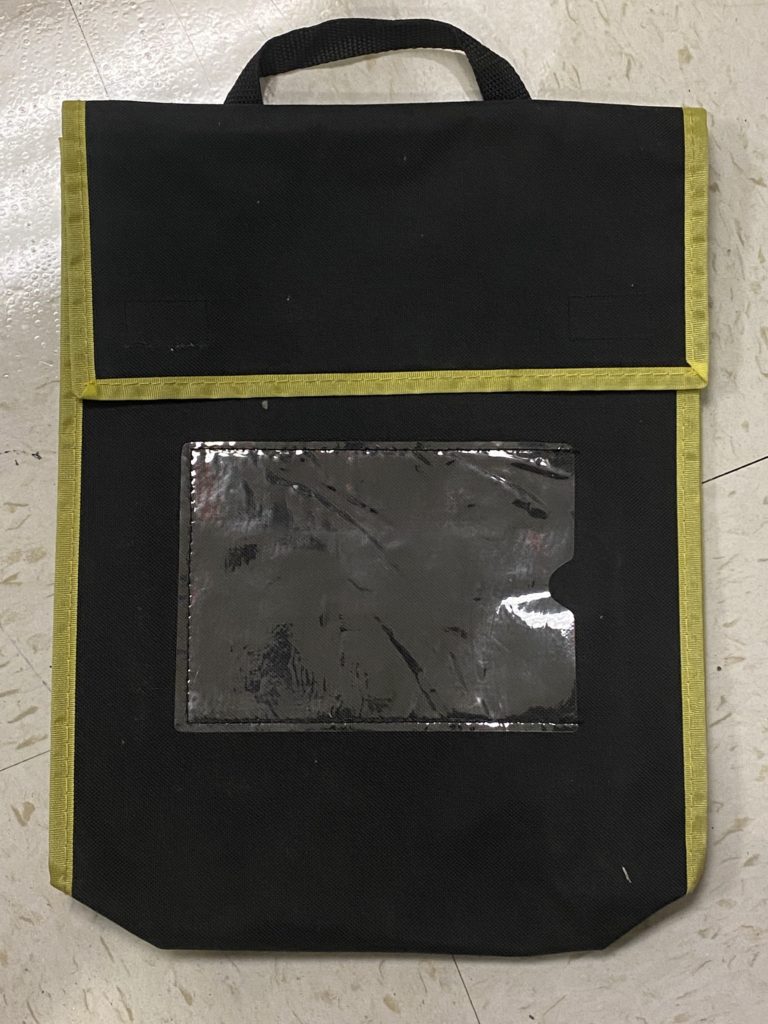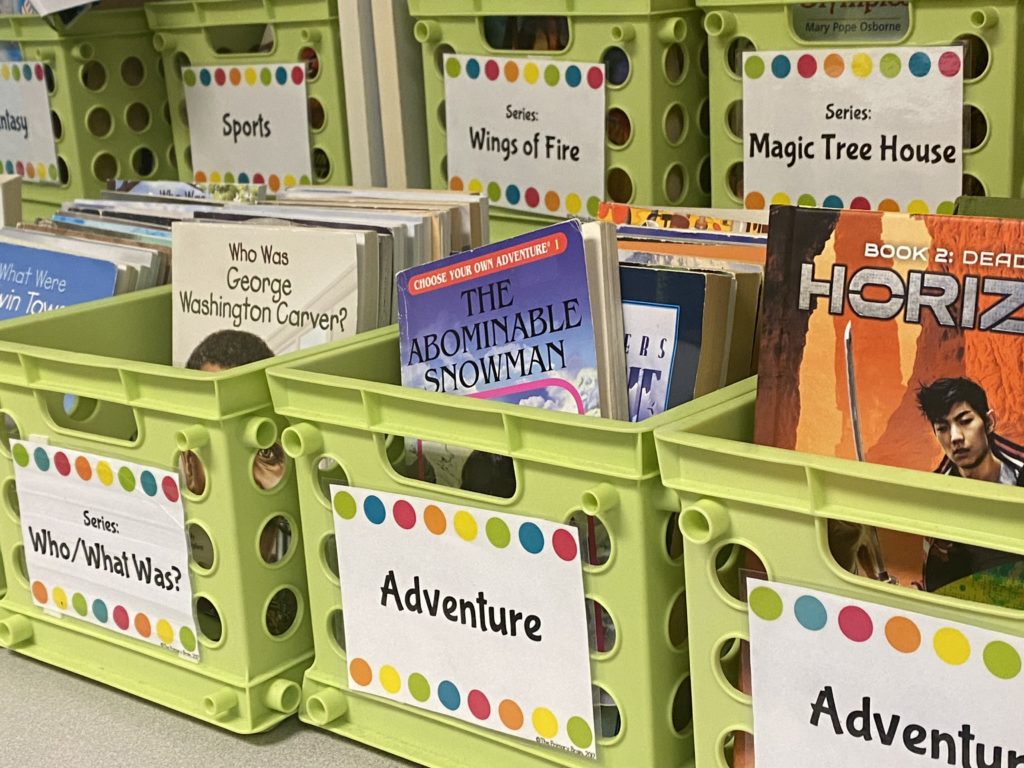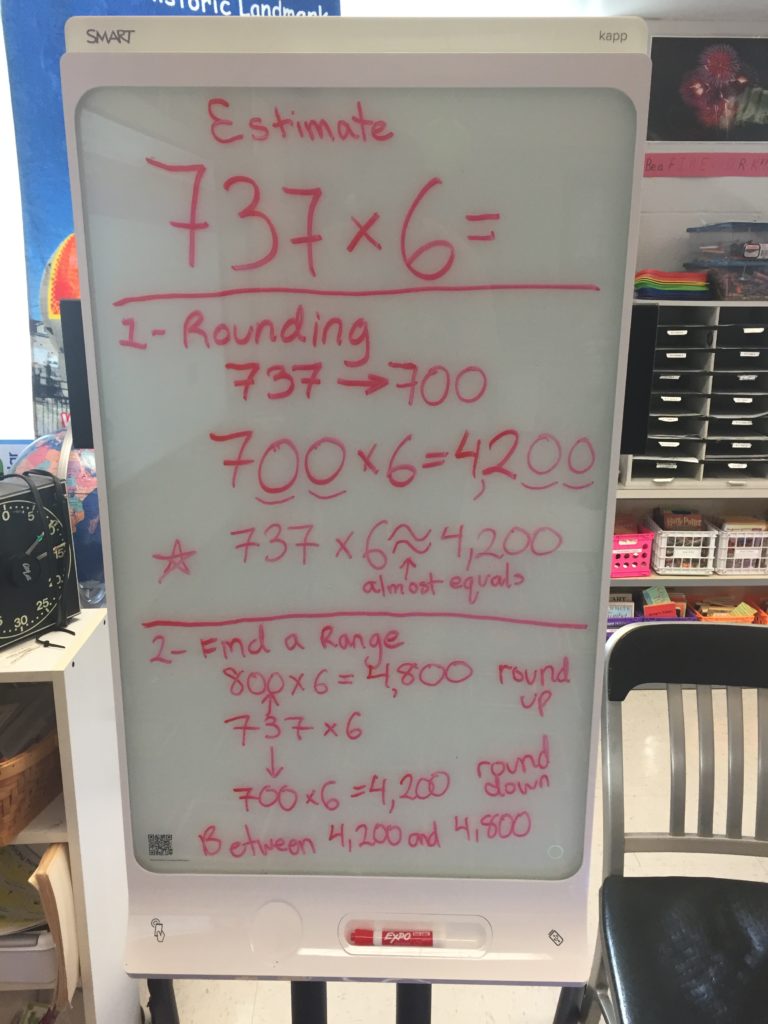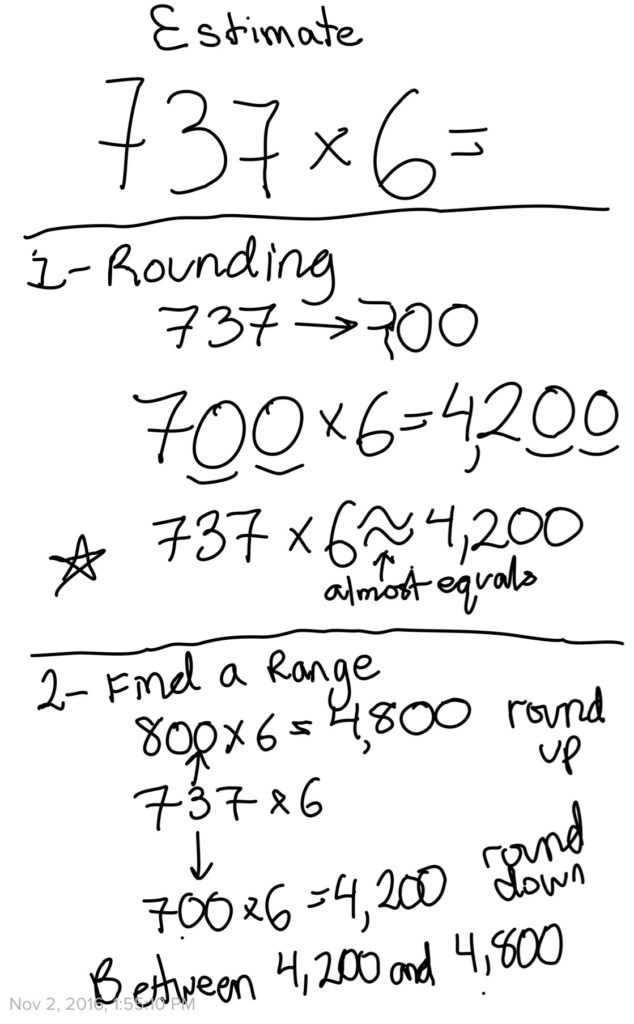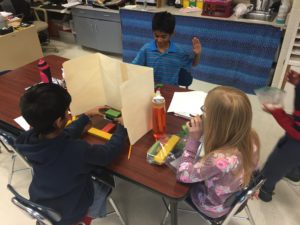Viewing: math
September 6, 2022
Class Library, Book Bags, Math Mindset, and more!
In class today, after much anticipation, our class library opened for business! We spent a lot of time discussing how the library is organized, our routines for checking out and returning books, and much more! Students each received a black and yellow bag for bringing home (and returning to school) one or two books each night. This should come home nightly and should be returned the next day. In the next week or two, I will start sending home reading logs for kids to use to track their reading. (More on this in the coming weeks.) The kids were VERY excited to begin using our massive class library (which, I’m proud to say, offers well over 1,000 books)!
One of the students’ homework assignments this week is to build a list of between four and eight of their current favorite books. Families are welcome to help their kids, as I know it can help the fourth graders to have someone to remind them of books they’ve enjoyed. But students are welcome to complete this independently if they prefer. This is due Friday morning and will help us to kick off our efforts to build life-long readers.
Today, we launched our year of math by discussing the challenges I had with math as a child and by talking about the importance of a growth mindset. We watched an amazing video by Jo Boaler, a researcher and professor of math education, all about building sound and sustainable habits when working on math. The kids’ math homework is to share this video with a grown-up at home and to discuss it. The link is in their Google Classroom page, and as you watch the video, it will periodically pause to present a question/topic for you and your fourth grader to discuss. I know your schedules are very busy, so I’ve asked kids to finish it by Friday. If you would like the weekend to get it done, that’s no problem. Just send me a quick email.
One of the ideas presented in the video is about the relevance of grades. You’ll find that math assessments are one of the only worksamples that will come home with a percentage grade on it. I don’t like relying on percentages, because I think they give you an incomplete understanding of your child’s progress. Consider this scenario:
Imagine a class takes a 16 item assessment that is divided into four sections, each with four items. “Mary” gave one incorrect answer in each section, so she has a score of 12/16, or 75%. Because Mary correctly solved most of the problems in each section, I would consider her to be making “good progress,” despite 75% being seen by SOME as lack-luster score. Another student, “Bobby” also scored 12/16 (75%), but in his case, he had all four of his incorrect answers in a single section. This indicates that there was one area in which he needed more intensive review and support. Both kids received the same score of 75%, but their assessments yielded very different results.
This is just one example of the dangers of over-emphasizing the total score. When I review student work, I look at what they DO know, not what they DON’T know, and I ask you to do the same. I’ll write more about this before the first math assessment comes home, but here are a few highlights to consider as you talk about grades with your child while watching the video:
- Kids are more than test scores. So often, they base their self-image of how they’re doing on measurable metrics. They think that a good math grade means that they’re smart and good at math, and that a poor grade means they’re dumb and bad at the skill. This couldn’t be more wrong! I’ve seen outstanding students who struggle with test-taking or get overwhelmed by long assessments. (We work on these challenges together.)
- PLEASE, PLEASE, PLEASE do not set percentage goals for assessments. When students learn that 80% is the minimum acceptable grade, for example, it means that a 78% is a disaster. Surely two percentage points doesn’t make or break a child’s success in fourth grade. Instead, set behavioral goals, like “Answer each question fully, without skipping steps.” or “Check your work over to make sure your calculations are accurate.” or “Reread problems to make sure you correctly understood the question.” or “Draw the problem out to better understand it.” Grades are just one indicator of progress. They don’t solely indicate success or failure.
- When your child brings home work, start by looking for strengths. So often, we parents begin by quickly looking for the ink from a teacher’s pen to see where there were mistakes. But wouldn’t we rather see our kids’ successes? Reinforce the successes, rather than dwelling on the mistakes.
- When you do see mistakes or lost points, talk with your child about why it happened. Don’t blame, just reflect. Consider a math assessment in which your child got a 66%. I think we can all agree that we’d like our kids to do better. But think back to that example I offered above. This is a similar situation. Ask yourself: Was it a 66% because your student really struggled with one part of a concept, or was the challenge spread out more consistently? Even if the lost points were distributed throughout the assessment, think about what a 66% means. A student CORRECTLY answered 2/3 of the assessment to earn those points. Clearly he or she knows a lot about a concept to do that well to begin with, even if a 66% feels disappointing to us. Start with that mindset, and then work from there.
I hope this was helpful for you, and I look forward to talking more as the year continues! As always, feel free to reach out to me with any questions!
Posted in Class Updates|By Jon Moss
November 4, 2018
Methodical Math Mania!
In room 209, we have been working hard on a variety of different math skills. In our current unit, which we’ll be assessing this week, students have learned about factors, multiples, the order of operations, patterns, problem solving, and more. I hope that the videos I’ve posted are helpful to you, both in keeping you up to date on what skills we’re covering and in better equipping you to support your fourth grader. Students have been working very hard in math.
Our first math unit focused on place value, addition, and subtraction. You may be wondering about the unit 1 assessment scores. When I review student assessment results, I look to see what strengths emerged and which areas were challenging for students. When I see that a few students have struggled with a particular area, I pull groups to review the difficult skills. When the number of students struggling with a skill is larger, it shows me that I need to do some reteaching for the whole class. On the unit 1 assessment, I saw that the majority of students continued to need practice with rounding and with a few other place value skills. Over the past few weeks, I’ve been reviewing various skills with small and large groups of students, and we’re going to continue this work to ensure that students have a solid foundation for our upcoming units. So while these assessments haven’t gone home yet, I look forward to reviewing them with you in person at our upcoming parent conference so we can discuss your fourth grader’s progress.
We’re also working on improving students’ addition and subtraction facts. Students are making progress in these skills, but this may also be a good focus for home practice. This may come as a surprise for you, as the big focus in third grade was multiplication. Fear not, we’ll soon return to multiplication facts as we dive into the multiplication units of study. But I often find that students’ addition and subtraction fact mastery tends to slip when they shift their focus to multiplication. So by taking the first marking period to work on addition and subtraction facts, I’m again hoping that students will have a solid basis for the skills in the upcoming units of study.
Posted in Class Updates|By Jon Moss
September 24, 2018
Starting Homework
Hello, families! Today, we’re kicking off our homework routines. They’re quite a bit different from past years, but I strongly believe we’re improving the learning process for kids in making these changes. Each week, students will receive a single math assignment. It is intended to be completed over multiple nights and will cover a variety of topics that we’ve taught in prior weeks. The idea is that the concepts on the homework aren’t BRAND new and, instead, are ones with which students have had a good amount of practice. (We all know how frustrating it is for students – and families – when they bring home a worksheet based on the day’s challenging lesson, and come home thoroughly baffled! That doesn’t help anyone! By basing the week’s homework on past weeks’ skills, ones they’ve practiced and applied, I’m hopeful that students will feel more confident and proficient.) When there’s something on the homework that I expect will be unfamiliar to parents, I will do my best to send out a video to help families understand the strategy we’re using in class. Tonight, for example, you’ll see two items that involve renaming numbers. (2,900 = __ hundreds, for example.) Here is a pair of videos to bring you up to speed on the strategy I’ve taught students.
Homework for reading and writing will take more of a varied form. Sometimes, it will be an activity directly tied to a skill we’re working on in class. For example, this week, students will be asked to keep track of the thoughts they have as they read. (We’ve been working on this a lot in class.) Other times, students will be given an assignment tied to the book they’re reading at home. Or their homework may set the groundwork for an upcoming lesson.
Remember, students always have free-choice reading for homework (around 30 minutes), and they should always take time to practice those often-elusive math facts. Stay tuned for ideas on both of these responsibilities.
If you ever have any questions about homework or anything else, please feel free to contact me!
Posted in Class Updates|By Jon Moss
October 23, 2017
Let’s add up what we’ve learned in math!
Our first math unit focused on place value, addition, and subtraction. Throughout the unit, you may have noticed several tutorial videos that I posted on our class website. I make these as a way of extending my instruction to the home setting, and to also help you to best help your fourth grader. I’ve been posting these on our class website, but starting now, I’ll instead post them in our Google Classroom account. This makes it easier for students to access them, and it allows me to catalog them by subject.
Today, students are bringing home their first math assessment. I have a practice of not returning corrected assessments until all the students have completed them, and that only recently happened. I found a wide range of student performance on the assessment. Let me tell you a bit more:
- Question 21 was challenging for many students. If you find your student’s grade was lower than you would like, take a look to see that problem. It was worth 6 points, and since the whole test was worth 35 points, it had a big effect on students’ overall grades. We’re going to review that problem type in depth on Thursday this week.
- In Targeted Instruction, students work on skills that are right for them. Based on their performance on the math assessment, many students are reviewing place value skills in general or rounding skills in specific during the TI block. So while you’re just now receiving these assessments, please know that students in either of these groups are entering their second week of focused, small group practice with these skills. Your child can tell you if he or she is in one of these groups.
- We’ll continue to improve students’ understanding of place value throughout the year as we progress through other units.
If you have any questions, please feel free to email me. We’re wrapping up the second math unit this week, and I expect to be giving the unit 2 assessment either on Friday or early next week.
Posted in Class Updates|By Jon Moss
November 2, 2016
What’s New in November?
As much as I love watching the fall foliage in October, I must admit that I am relieved that it’s over! Two district curriculum meetings, one conference presentation, 26 DRAs (and counting), and plenty of other projects made October a productive but exhausting month! As I dig out from the month that seemingly never ended, I’m looking forward and am excited to share three new things happening in our classroom!
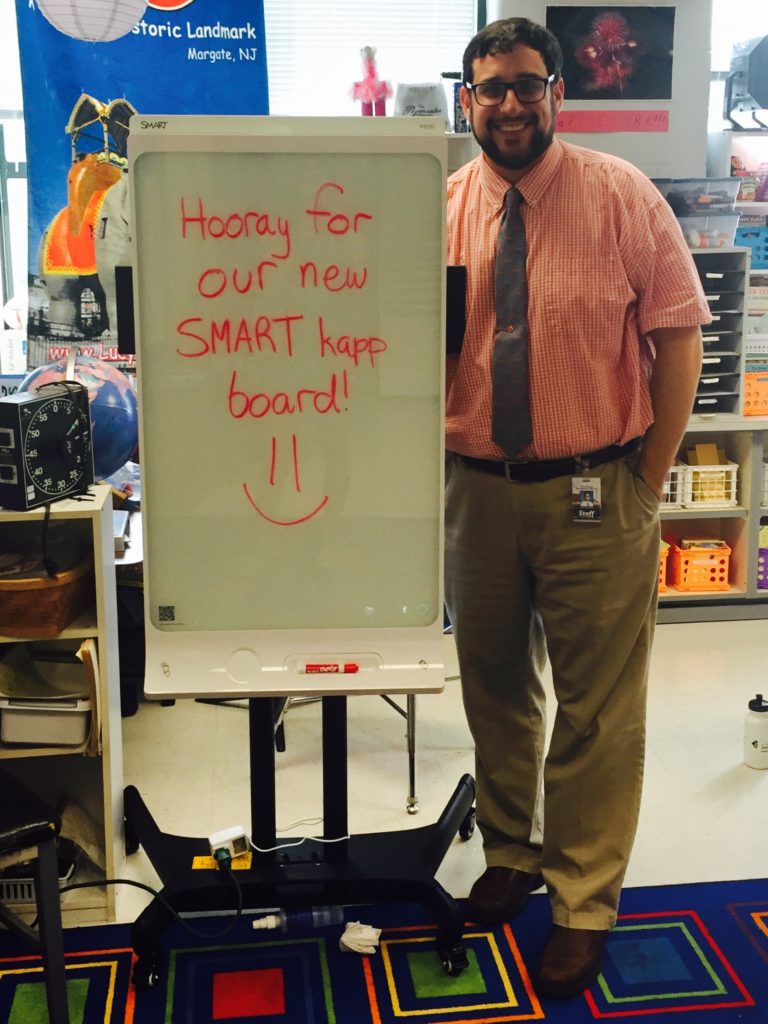 Last Tuesday, I presented at the 2016 CECA/CASL conference about how to integrate collaborative eLearning into classroom instruction. (If you’re interested in learning more about my conference presentation, visit my Teachers and Technology link up top, or click here.) I think it was my lucky day, as I ended up leaving with a new document camera for our classroom and an interactive whiteboard setup (evaluation products from a vendor we’ve used in the past), and a bag of books from a raffle. But my big win was being randomly chosen to receive a “SMART kapp” board for our classroom! SMART kapp is a dry erase board that can capture a snapshot of what’s written on it. By pairing it with my phone, I’m able to take what’s written and upload it to Google Drive (to share in Google Classroom), save it as a PDF or JPG image, and more. I’m excited by its potential to let me share notes from class with students and families in order to support homework. After ordering and assembling a stand, I was excited to try it out today for the first time, and so far, I’m impressed! We used it for a math lesson today, and I uploaded our notes to Google Classroom for the students to use this evening. It’s still new, so we’ll see how it best helps us in class, but I welcome and appreciate your feedback! Here’s a sample of how it looks in real and recorded images:
Last Tuesday, I presented at the 2016 CECA/CASL conference about how to integrate collaborative eLearning into classroom instruction. (If you’re interested in learning more about my conference presentation, visit my Teachers and Technology link up top, or click here.) I think it was my lucky day, as I ended up leaving with a new document camera for our classroom and an interactive whiteboard setup (evaluation products from a vendor we’ve used in the past), and a bag of books from a raffle. But my big win was being randomly chosen to receive a “SMART kapp” board for our classroom! SMART kapp is a dry erase board that can capture a snapshot of what’s written on it. By pairing it with my phone, I’m able to take what’s written and upload it to Google Drive (to share in Google Classroom), save it as a PDF or JPG image, and more. I’m excited by its potential to let me share notes from class with students and families in order to support homework. After ordering and assembling a stand, I was excited to try it out today for the first time, and so far, I’m impressed! We used it for a math lesson today, and I uploaded our notes to Google Classroom for the students to use this evening. It’s still new, so we’ll see how it best helps us in class, but I welcome and appreciate your feedback! Here’s a sample of how it looks in real and recorded images:
Our second “New in November” item is math rotations. This may be familiar to you from third grade. Traditional math lessons take about 60 minutes and may be comprised of 40 minutes of whole class 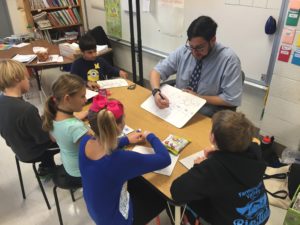 instruction and 20 minutes of independent or small group practice. What’s tough about that is that in that 40 minutes, there are students who are ready to move on after 10 minutes, and students who need more support beyond what was already taught. At PGS, we’re working to be more responsive to student needs, so we use math stations to better differentiate our instruction. The whole class lesson is shorter, only 15 or 20 minutes, and then students split up into assigned groups for math rotations. Students visit four stations in a given day: the teacher station (for small group, customized instruction about the skill I introduced in the minilesson), the practice station (for practice with that same skill), the hands-on station (where there is a game or other fun activity to let students reinforce various math skills), and the fluency station (where students work to maintain their computational fluency – aka adding and subtracting and later, multiplying and dividing).
instruction and 20 minutes of independent or small group practice. What’s tough about that is that in that 40 minutes, there are students who are ready to move on after 10 minutes, and students who need more support beyond what was already taught. At PGS, we’re working to be more responsive to student needs, so we use math stations to better differentiate our instruction. The whole class lesson is shorter, only 15 or 20 minutes, and then students split up into assigned groups for math rotations. Students visit four stations in a given day: the teacher station (for small group, customized instruction about the skill I introduced in the minilesson), the practice station (for practice with that same skill), the hands-on station (where there is a game or other fun activity to let students reinforce various math skills), and the fluency station (where students work to maintain their computational fluency – aka adding and subtracting and later, multiplying and dividing).
There is a set order for these rotations, so for many students, they’re having a 15 or 20 minute minilesson, immediately followed by a 10(ish) minute small group session to work on the same skill. This seems like less time, but the small group setting means that I can provide targeted instruction to students in a more meaningful, efficient way. Other students will see me after visiting one or two or three other stations, but this model ensures that everyone gets the support that he or she needs. Please understand that there are days in which we may not have math rotations, often when we’re introducing a new skill that warrants more time for whole class instruction.
Our final “New in November” is a shift in our class’ conduct system. For the first few weeks of school, groups competed to earn points, and the group with the most points on Friday would earn a few minutes of free time. This works well, and while the friendly competition generally stayed friendly, I wanted to raise the bar for the students. Starting this month, we’re shifting to a cooperative model. Groups are still working to earn points for their team, and we may still have the winning group receive their prize, but the class is working toward a larger goal, too. When ALL the groups have earned 50 points (each), the class will earn a theme day, such as pajama day, 80’s day, etc. That means that in addition to students within a group helping their teammates to make good choices, we also have each group helping one another. The prize won’t come until each group reaches 50, so there’s an incentive for students to support one another in order to achieve their shared goal.
As always, if you have any questions, please feel free to contact me!
Posted in Class Updates|By Jon Moss
September 12, 2016
Video and Slides from Curriculum Night
Click here to download the PDF of my 2016-2017 Curriculum Night presentation!
Posted in Class Updates|By Jon Moss
February 28, 2016
Changing Math Lessons for Unit 6
As you may know, I am one of the two teachers from the PGS fourth grade team who are on the math curriculum committee for our grade. With three counterparts from RBS and our district K-6 math coach, we meet ever few months to continue the process of revising our math instruction. (I’ll be out next Monday morning to attend one of our curriculum work days.) When we transitioned to align with the Common Core two years ago, we found that our former series, Everyday Mathematics, was no longer appropriate in its entirety. As we rewrote our fourth grade math curriculum, we worked to pull materials and resources that were best suited for teaching a given concept or skill. Sometimes those resources came from individual Everyday Math lessons that we thought fit the objectives particularly well, sometimes they came from OnCore (which accounts for most of the worksheets you have seen come home), and occasionally we pulled in miscellaneous resources (including SMART Notebook lessons from SMART Exchange, homework or classwork worksheets from different sources, etc.)
 Four our new math unit, which focuses on adding, subtracting, and multiplying fractions, we are using a new set of resources that we piloted last year. EngageNY is a resource made available by the New York State Department of Education. The state has developed Common Core-aligned lessons and resources for each grade, and we have found that the lessons are well-structured, include valuable resources, and integrate an appropriate amount of rigor (while not being unreasonably difficult). As a team, we have found that the program is particularly well-suited for teaching fractions (especially the concepts covered in the current unit). You and your fourth grader will see a few changes, and plenty of similarities too:
Four our new math unit, which focuses on adding, subtracting, and multiplying fractions, we are using a new set of resources that we piloted last year. EngageNY is a resource made available by the New York State Department of Education. The state has developed Common Core-aligned lessons and resources for each grade, and we have found that the lessons are well-structured, include valuable resources, and integrate an appropriate amount of rigor (while not being unreasonably difficult). As a team, we have found that the program is particularly well-suited for teaching fractions (especially the concepts covered in the current unit). You and your fourth grader will see a few changes, and plenty of similarities too:
- Lessons are more structured. While worksheets are still included for practice at the end of lessons, they are less emphasized than other lessons we have considered. They will continue to be completed during math rotations.
- The word “tape diagram” is introduced. It means the same as “bar model” (which your kids should certainly be able to explain to you!) Both terms will be used interchangeably. I think it’s a different term because of copyright issues. That said, you may have heard your students discuss the differences between tape diagrams and area models late last week. These are very similar visual models, but they do have differences. Ask your fourth grader!
- Lessons continue to begin with a number talk, which allows students to practice mental computation skills and to discuss different methods in which they solved a given problem.
- Lessons may end with exit tickets. These are very short (one or two question) worksheets that let teachers get a quick overview of student proficiency. They can be used in different ways, including informal assessments, warm-ups for the next day, etc. I use them sporadically.
- Classwork and homework worksheets have the potential to be more lengthy. There are times when I may ask students to complete a whole assignment. Other times, I may ask kids to complete certain sections. Overall, however, the assignments will have more items than the five-item worksheets you remember from OnCore. Additionally, most items are open-ended, as compared to the OnCore multiple choice homework worksheets. This allows students to better apply their skills. Homework worksheets more closely resemble the classwork pages, so a correct sheet from classwork can help a student as he or she completes the homework page. You’ll notice that I (almost) always will have kids bring home their classwork worksheets. Even though they may not be entirely completed (for the reasons explained above), I think they can often be helpful guides as kids complete their homework. Students do NOT need to complete the unanswered classwork questions, unless that’s specifically written as part of the night’s homework assignment. This practice should be familiar, as I did the same thing in previous units when we used OnCore materials.
As with all changes to our instructional plan, we will continue to meet as a team to review our progress, discuss what we like and don’t like about the new lessons, and revise our plans based on our experiences from students.
Please feel free to reach out to me if you have any questions!
Posted in Class Updates|By Jon Moss
October 14, 2015
Reviewing Math Skills
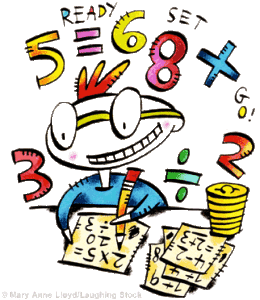 In late September, students completed the first math assessment. Normally, we strive to score these and promptly send them home for you to review, sign, and return to us. This time, however, we have intentionally held off on doing so. We found that there were several items on the assessment that were challenging to students, and we wanted to review many of these with the class. For the past few weeks, we’ve been reviewing skills with the whole class that were challenging for a large group of students. Mr. Walmer and I have also been pulling students to address skills that are best taught by repeated practice in small groups, such as rounding, multi-digit subtraction with regrouping, and standard form/word form/expanded form. As you receive and review the assessments, please rest assured that we are working with your fourth grader on any areas that he or she struggled with.
In late September, students completed the first math assessment. Normally, we strive to score these and promptly send them home for you to review, sign, and return to us. This time, however, we have intentionally held off on doing so. We found that there were several items on the assessment that were challenging to students, and we wanted to review many of these with the class. For the past few weeks, we’ve been reviewing skills with the whole class that were challenging for a large group of students. Mr. Walmer and I have also been pulling students to address skills that are best taught by repeated practice in small groups, such as rounding, multi-digit subtraction with regrouping, and standard form/word form/expanded form. As you receive and review the assessments, please rest assured that we are working with your fourth grader on any areas that he or she struggled with.
The final question on the assessment was a particularly challenging problem, in part, because it was not written in the most clear way. Many students lost points on this one question, and because it accounted for 9 points on the 36 point assessment. So you can see how struggling on this one question could dramatically impact students’ individual scores. For that reason, we strongly encourage you to look at your son or daughter’s performance on individual questions, rather than focusing on the percentage score (which, in all candor, tended to be lackluster for students throughout the class). Additionally, Mr. Walmer taught a great lesson yesterday that reviewed that challenging final question. After practicing the skill in class, students completed a similar problem, and we are so pleased that ALL students improved on their score from the assessment. Those reteaching worksheets are stapled to the end of the students’ assessments.
We ask that you take time this week to review your child’s performance on the math assessment, sign it, and PLEASE SEND IT BACK TO SCHOOL. Once again, we encourage you to examine how your child did on individual problem-sets (in rows, with the row score on the left side of the page) in order to look for strengths and weaknesses. Please don’t dwell on the percentage score, which was (for many students) pulled down by one challenging question at the end of the assessment.
Posted in Class Updates|By Jon Moss
June 11, 2015
What’s New?
I was speaking with someone yesterday, and we got to talking about our class website. I realized that it had been quite some time since I posted an update for you! I apoglize for that oversight. The end of the year is notoriously busy, and this fell by the wayside. If you’ll share a few minutes of your time, I’ll bring you up to speed!
 This week, students finished presenting their TUSS projects! I was so very impressed by the kids’ work. This year, there was such a wide variety of research topics, and kids used so many different kinds of methods. I really admire the thought and care kids put into their projects. Stay tuned for feedback.
This week, students finished presenting their TUSS projects! I was so very impressed by the kids’ work. This year, there was such a wide variety of research topics, and kids used so many different kinds of methods. I really admire the thought and care kids put into their projects. Stay tuned for feedback.
This week, we’re wrapping up our unit about expository writing. This unit integrated our social studies focus of US regions by allowing students to research and organize information about the economy of a midwestern state. Students conducted research on the internet and in books, and they organized their information on a graphic organizer called an expository pillar. In doing so, students learned about thesis statements, how to structure main ideas and supporting details within a five paragraph essay, and how to craft a conclusion. This organization made the process of drafting the essay very simple!
We’ve recently completed our unit about measurement (focusing more on understanding different units of measurement, as opposed to actually measuring objects with rulers and scales) as well as a mini-unit about geometry.
Stay tuned for more information!
Posted in Class Updates|By Jon Moss
February 27, 2015
Changing Math Lessons
As you may know, I am one of the three teachers from the fourth grade team who are on the math curriculum committee for our grade. With three counterparts from RBS and our district K-6 math coach, we meet ever few weeks to continue the process of revising our math instruction. When we transitioned to align with the Common Core, we found that our former series, Everyday Mathematics, was no longer appropriate in its entirety. As we rewrote our fourth grade math curriculum, we worked to pull materials and resources that were best suited for teaching a given concept or skill. Something those resources came from individual Everyday Math lessons, sometimes they came from OnCore, and occasionally we pulled in miscellaneous resources (including SMART Notebook lessons from SMART Exchange, homework or classwork worksheets from different sources, etc.)
 Four our new math unit, which focuses on adding, subtracting, and multiplying fractions, we have chosen to pilot a new resource. EngageNY is a resource made available by the New York State Department of Education. The state has developed Common Core-aligned lessons and resources for each grade, and we have found from small pilots that the lessons are well-structured, include valuable resources, and integrate an appropriate amount of rigor (while not being unreasonably difficult). As a team, we have chosen to pilot this program for our new math unit. You and your fourth grader will see a few changes:
Four our new math unit, which focuses on adding, subtracting, and multiplying fractions, we have chosen to pilot a new resource. EngageNY is a resource made available by the New York State Department of Education. The state has developed Common Core-aligned lessons and resources for each grade, and we have found from small pilots that the lessons are well-structured, include valuable resources, and integrate an appropriate amount of rigor (while not being unreasonably difficult). As a team, we have chosen to pilot this program for our new math unit. You and your fourth grader will see a few changes:
- Lessons are more structured and include more instructional support. While worksheets are still included for practice at the end of lessons, they are less emphasized than other lessons we have considered.
- The word “tape diagram” is introduced. It means the same as “bar model” (which your kids should certainly be able to explain to you!) Both terms will be used interchangeably.
- Lessons begin with a number talk, which allows students to practice mental computation skills and to discuss different methods in which they solved a given problem.
- Lessons end with exit tickets. These are very short (one or two question) worksheets that let teachers get a quick overview of student proficiency. They can be used in different ways, including informal assessments, warm-ups for the next day, etc.
- Classwork and homework worksheets have the potential to be more lengthy. There are times when I may ask students to complete a whole assignment. Other times, I may ask kids to complete certain sections. Overall, however, the assignments will have more items than the five-item worksheets you remember from OnCore. Additionally, most items are open-ended, as compared to the OnCore multiple choice homework worksheets. This allows students to better apply their skills. Homework worksheets more closely resemble the classwork pages, so a correct sheet from classwork can help a student as he or she completes the homework page.
As with all changes to our instructional plan, we will continue to meet as a team to review our progress, discuss what we like and don’t like about the new lessons, and revise our plans based on our experiences from students.
Please feel free to reach out to me if you have any questions!
Posted in Class Updates|By Jon Moss

